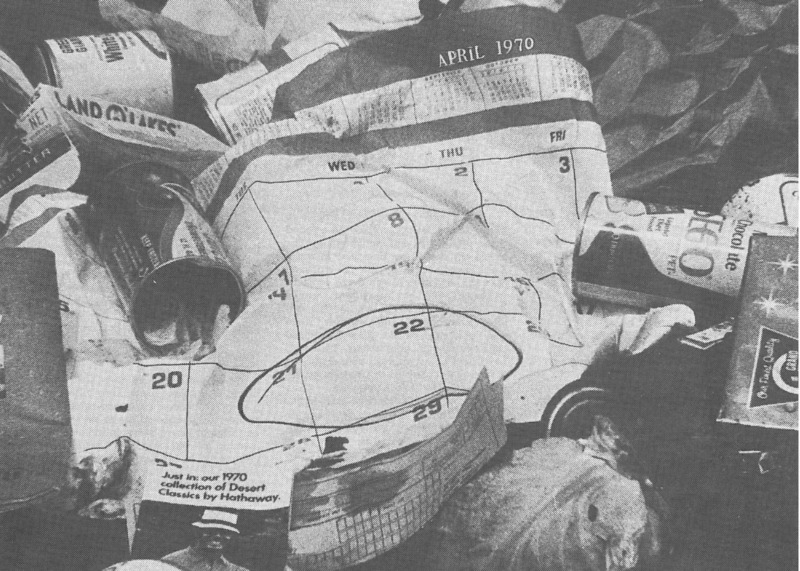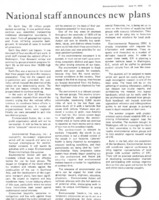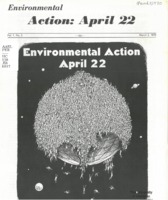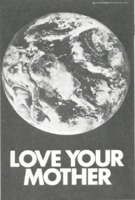Environmental Action Moving Forward
As many pointed out in their speeches, Earth Day was just the beginning. Environmental Teach-In, Inc. served as the national coordinating office for local groups on 2,000 campuses, 2,000 communities, and over 10,000 high schools for the first Earth Day. It was a tremendously impactful day; over 20 million people took part. Moving forward, the staff had to decide how best to focus their efforts to best promote their cause. After some consideration, they decided to split Environmental Teach-In, Inc. into two new groups: Environmental Action, Inc. (EA) and Environmental Resources, Inc. Environmental Action was a non-profit organization that was not tax-exempt and thus free to editorialize and advocates for issues of their choosing. One of its main functions would be to publish a biweekly newsletter to keep the public informed about important contemporary environmental issues. One of the main responsibilities of the other organization, Environmental Resources, Inc. would be to run a summer institute staffed by graduate students from across the country to do intensive research into issue areas. The first Earth Day was successful in that it cultivated a vast new area of the political capital, but EA was not always satisfied that real progress was being made from a policy perspective so they mobilized their resources to pursue new, policy-oriented goals.
The events of Earth Day served to raise awareness and increase the political discourse across the country and they transcended ideological boundaries, but after the big day was over, the organization had the unique challenge of trying to maintain some level of the national fervor that had been incited. After educating the masses about the nature of the problem, they needed to transform this education into action. Earth Day raised people’s awareness, so Environmental Teach-In wrote the Earth Tool Kit to show people what they could do about the problem. The book looked at simple, practical ways people could get directly and politically involved.
The Environmental Action Newsletter was integral to the strategy of the organization moving forward from Earth Day. The first issue was published in January of 1970, and distributed to over 7,000 individuals and their membership only grew from there. They used the newsletter to keep their reading base informed about events across the environmentalist world. Their priorities and issues were constantly evolving to keep up with the times and also as their staff and editors changed. Click the image of the cover to the left to view the entire third issue of the newsletter, including articles about pollution, power companies, labor unions, taxes, environmental movies, and more.
Environmental Action reported on a broad portfolio of issues after Earth Day. The Clean Air Act and the Clean Water act were frequently discussed along with nuclear power and the Vietnam War. A considerable amount of ink was devoted to issues about highway construction and mass-transit. Environmental Action often ran radical critiques of the corporation and government interests. They also focused on environmental justice, a concept, which hadn’t been clearly defined at the time, but dealt with pollution and impoverished people, minorities, and other disadvantaged subsections of the population. The newsletter allowed them to clearly define their politics and priorities as an organization and because the publication was bi-monthly, these opinions were constantly being adapted and updated.
Industry and government were often at the center of Environmental Action’s enemies. Denis Hayes and Barbara Reid spoke out against the industry in their Earth Day speeches, and this skepticism permeated through EA in the 1970's. In an article from January 9, 1971, issue of their newsletter, Environmental Action thanked industry (sarcastically of course) for their many contributions to society. The article reads “Thank you, industry for oily water, mercury, supersonic transport, superhighways, emphysema, and inaction.” According to EA, the industry was trying to seduce the American people with products like the trash masher, which were portrayed by public relations teams to be a green alternative to throwing your garbage in a landfill, but in reality, caused much more harm than good. Chevron was heralded as the most generous donor of oil to the ocean depths. For Environmental Action, it was clear where much of the blame for the environmental crisis should be placed. Another article, titled “Why does Industry always get what it wants?” connects the dots between industry and government as responsible for the environmental crisis. In the early 1970s, the US government created many new environmental control tools in the government such as the Environmental Protection Agency and the Council on Environmental Quality. Environmental Action argued that the creation of this bureaucracy was just for show because the industry still retained a lot of power to influence the decisions made by these organizations. These institutions and advisory committees actually provided a more formalized mechanism for private interests to gain access to government bureaucracy.
The organization took a far-left approach to the environmental movement according to Peter Harnik. After Earth Day, they devoted a lot of ink to government and corporate practices that they opposed. A regular feature of the newsletter was "Debunking Madison Ave." Denis Hayes said in his speech on Earth Day that corporations had a tendency to exaggerate or mislead the public about their green contributions to society. In this section, Environmental Action reproduced ads from magazines and newspapers across the country that depicted corporations as environmentally sound. These ads heralded the strides corporations had made in protecting the environment, but EA researched and refuted those claims.
Environmental Action had a complicated relationship with government, especially the Nixon administration. They felt the administration did not do enough to further the goals of the environment. "We felt that they were not doing nearly enough," said Peter Harnik. "Everything they were proposing was either too late, too little, too weak, or misguided." However, in retrospect, legislation like the Clean Air and Water Acts are still cornerstones of US environmental policy today. Denis Hayes also discussed the paradoxical nature of the Nixon administration's environmental contributions. President Nixon himself was not much of an environmentalist and yet, he created the Environmental Protection Agency and appointed William Ruckelshaus as its head.
Environmental Action also faced the question of what to do with Earth Day itself. Initially, they decided to step back and allow local groups to continue to organize events on the holiday. There were efforts to make the third week of April Earth Week, instead of just celebrating Earth Day. The events themselves would be local in nature, but Senator Gaylord Nelson and Environmental Action decided that people should renew their focus on the global dimensions of the environmental crisis. Nelson and EA continued to lobby for Earth Week events in schools across the country and large-scale events were planned for the 25th and the 30th anniversary of Earth Day. In a 2015 interview, when asked to differentiate between Earth Day today and the first Earth Day, Denis Hayes said "Perhaps the most important difference is that the first Earth Day was purely American. This year, there will be Earth Day activities in at least 170 nations."
Sources for this Page
Adam Rome, The Genius of Earth Day: How a 1970 Teach-In Unexpectedly Made the First Green Generation.
Environmental Action National Staff "Earth Day- The Beginning," 1970.
Environmental Action National Staff "Earth Tool Kit," 1971.
Environmental Action Newsletters.
Gaylord Nelson and Earth Day: The Making of the Modern Environmental Movement, Wisconsin Historical Society, http://www.nelsonearthday.net/collection/
Interview of Barbara Alexander (Reid) by Kiegan White, November 9, 2017, Ann Arbor, Michigan.
Interview of Peter Harnik by Kiegan White, December 8, 2017, Ann Arbor, Michigan.






